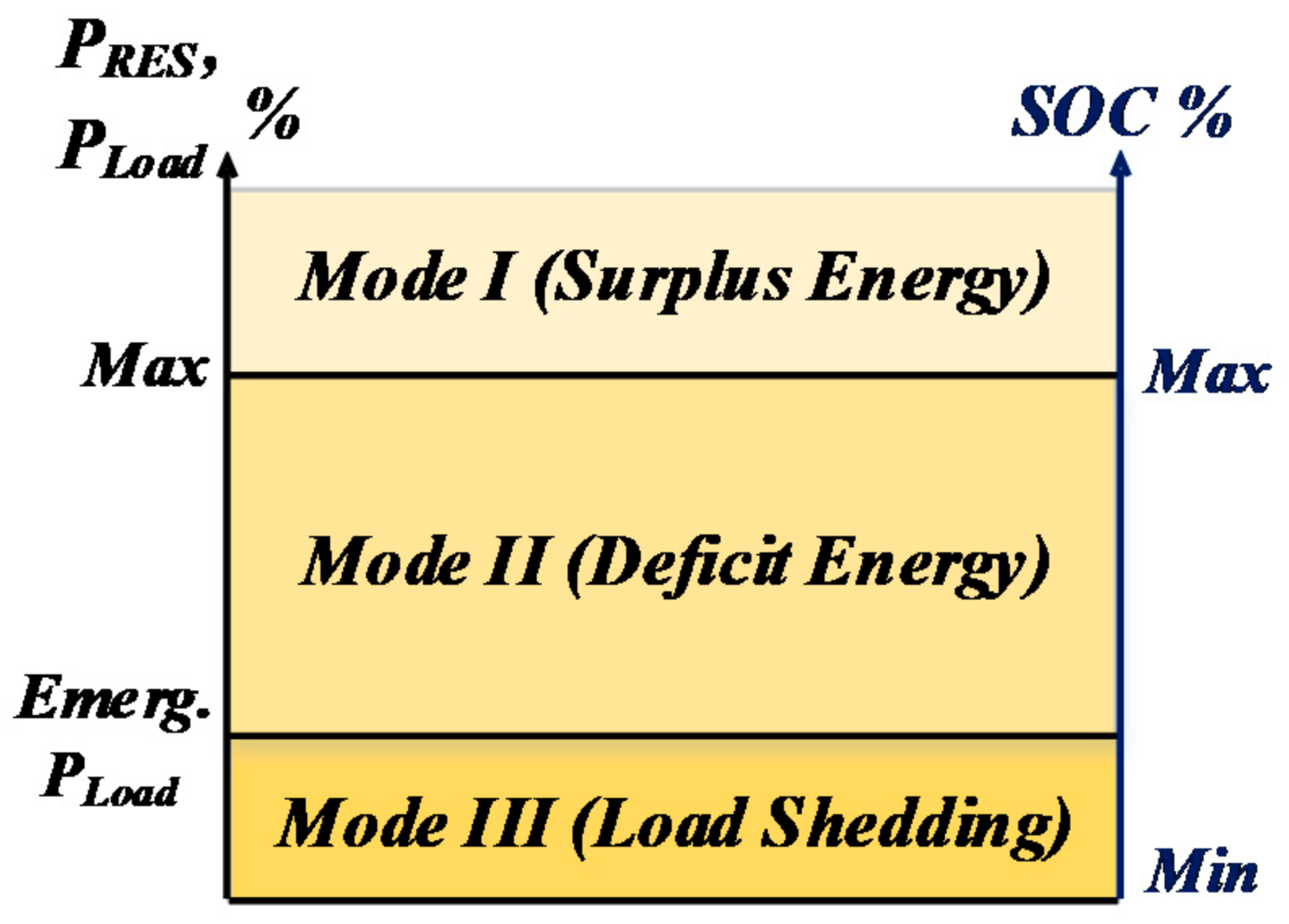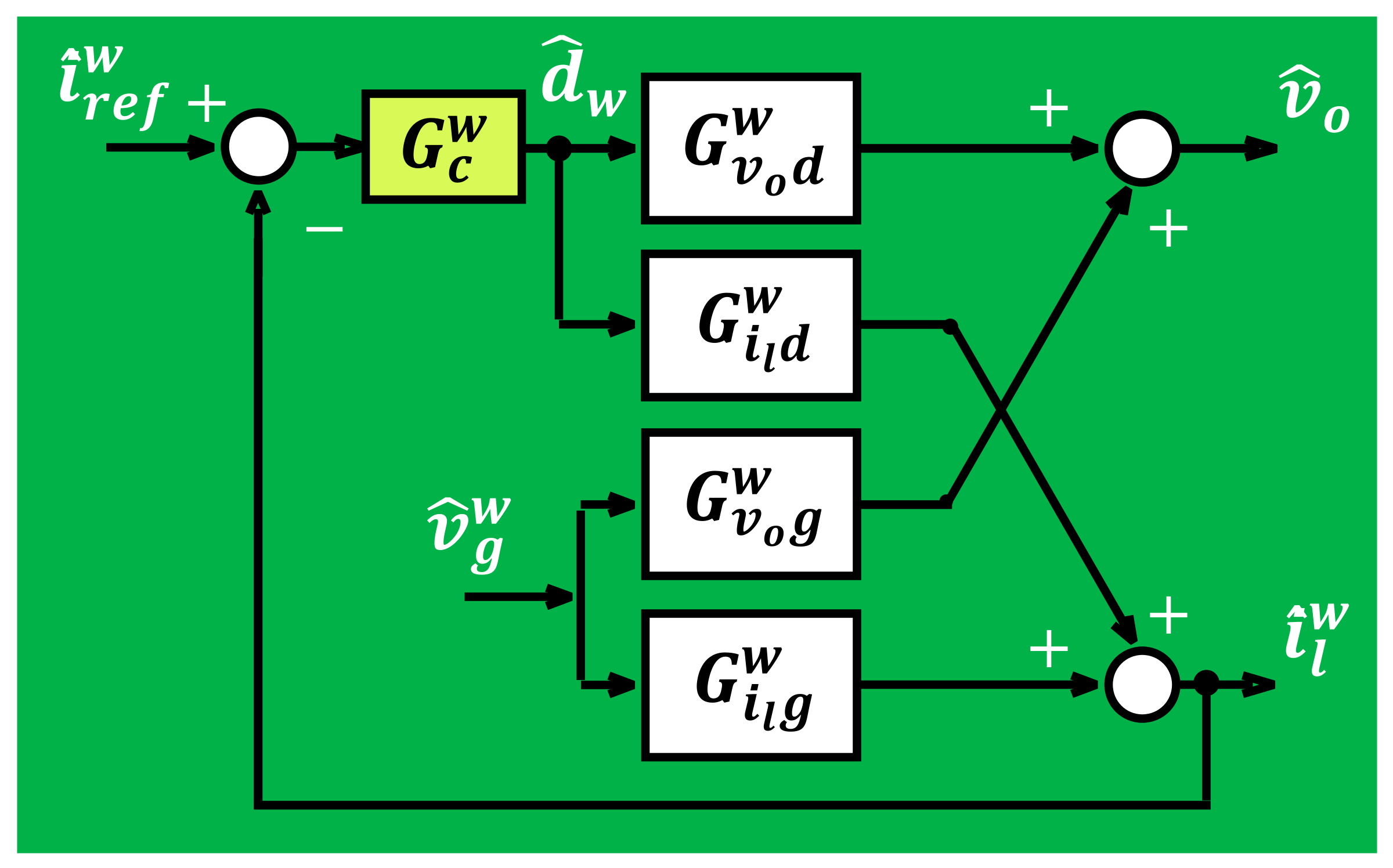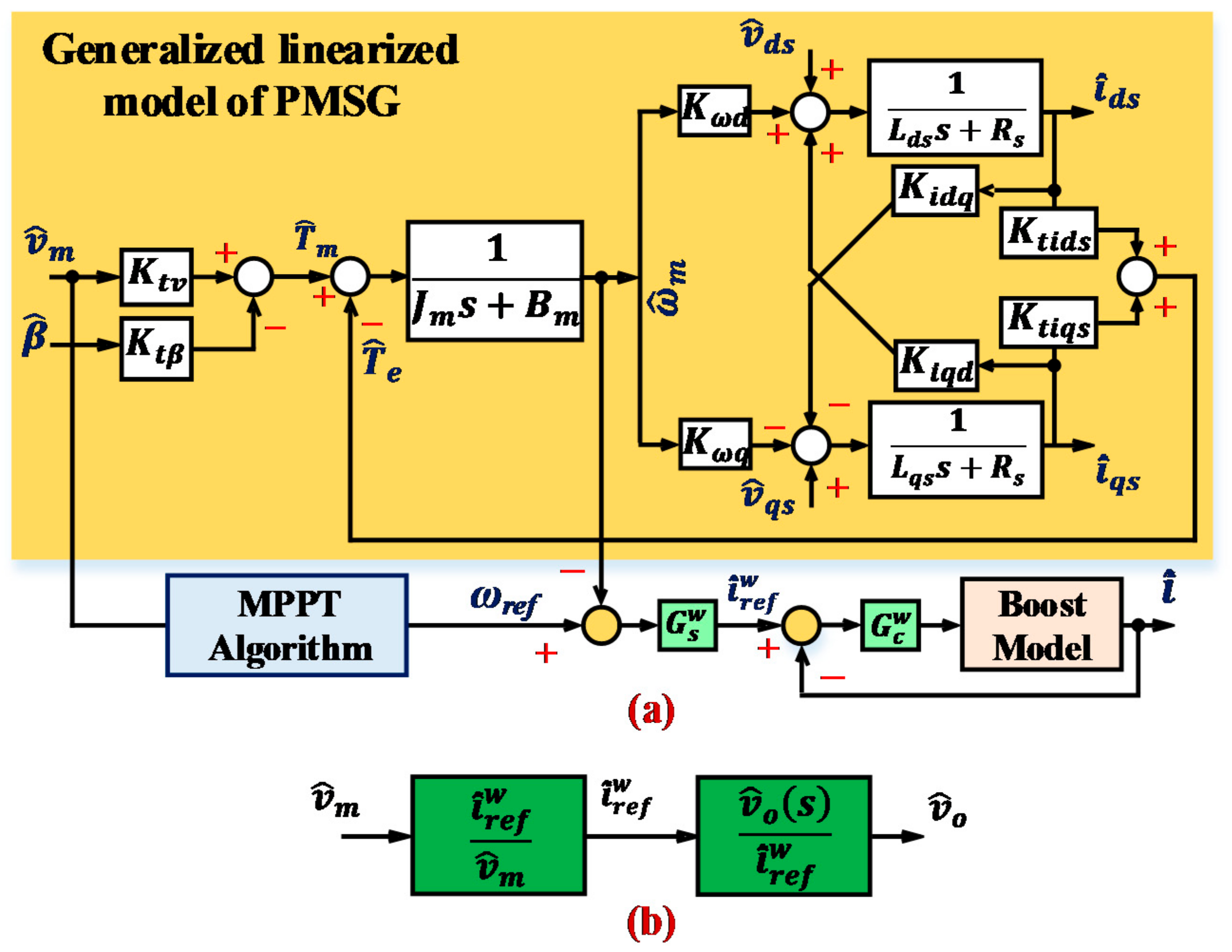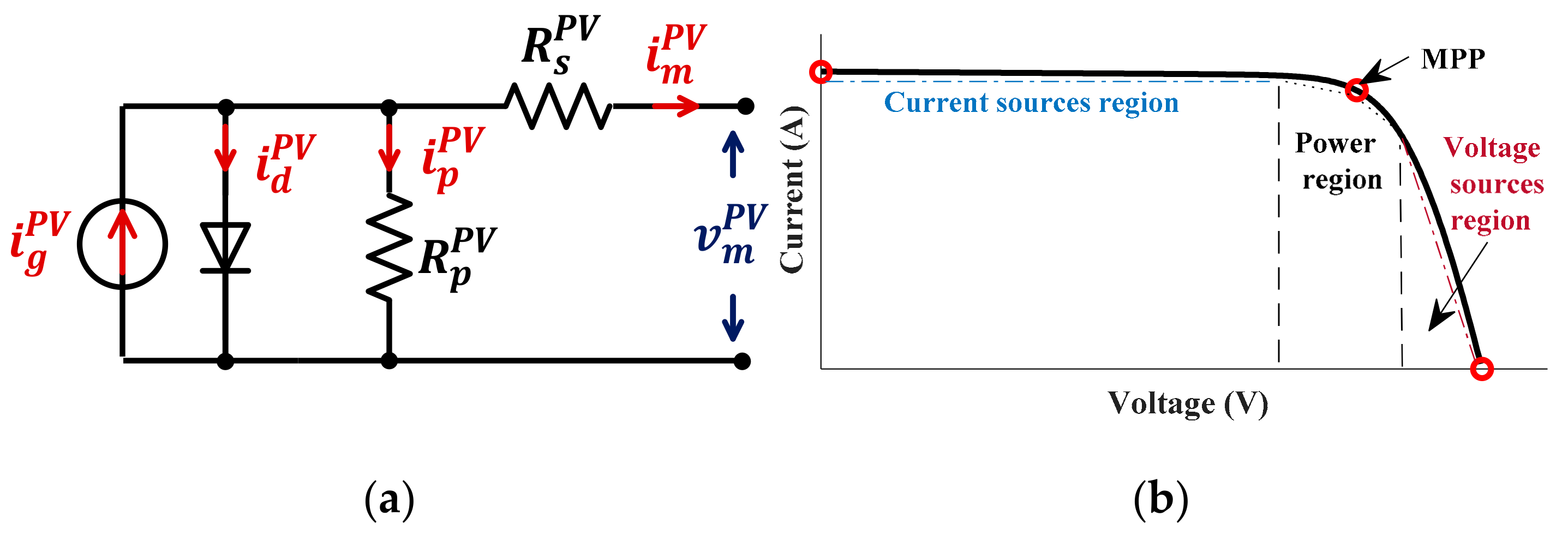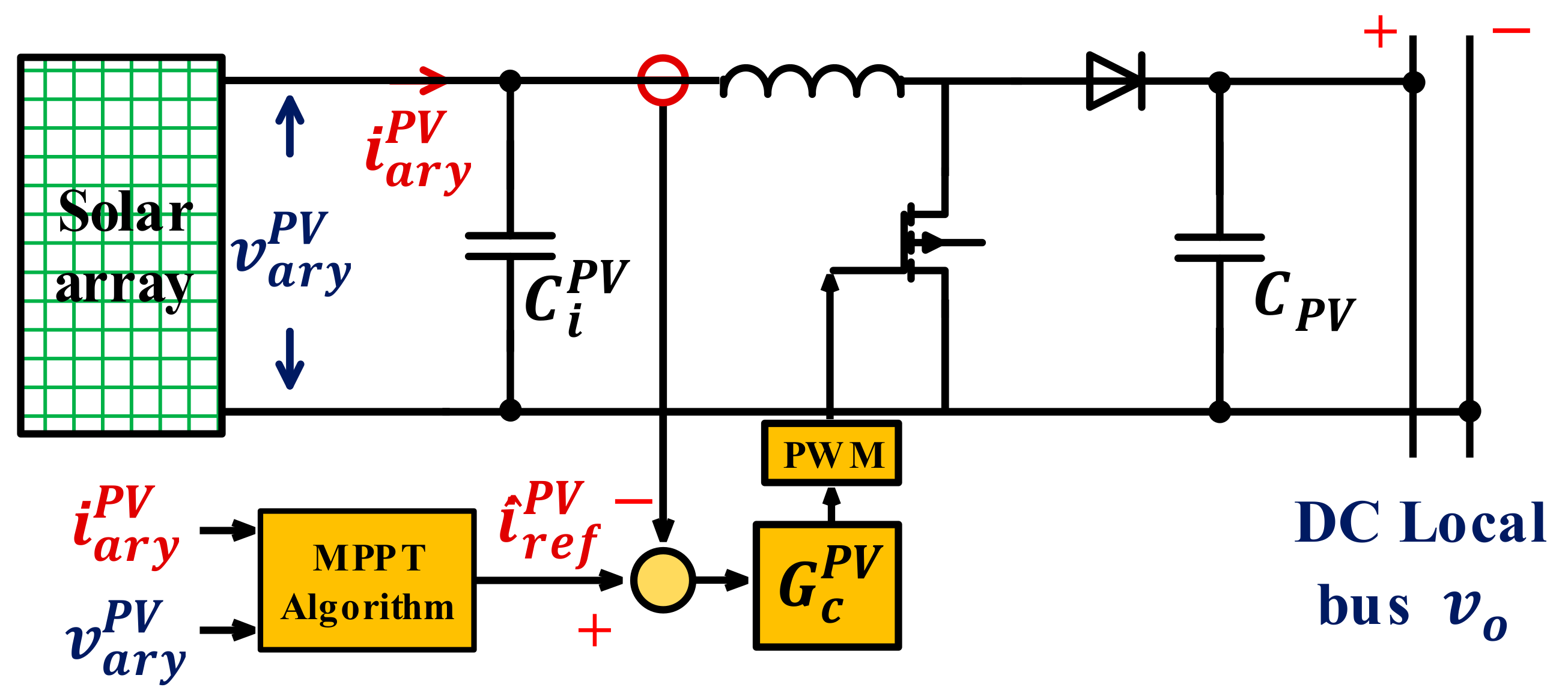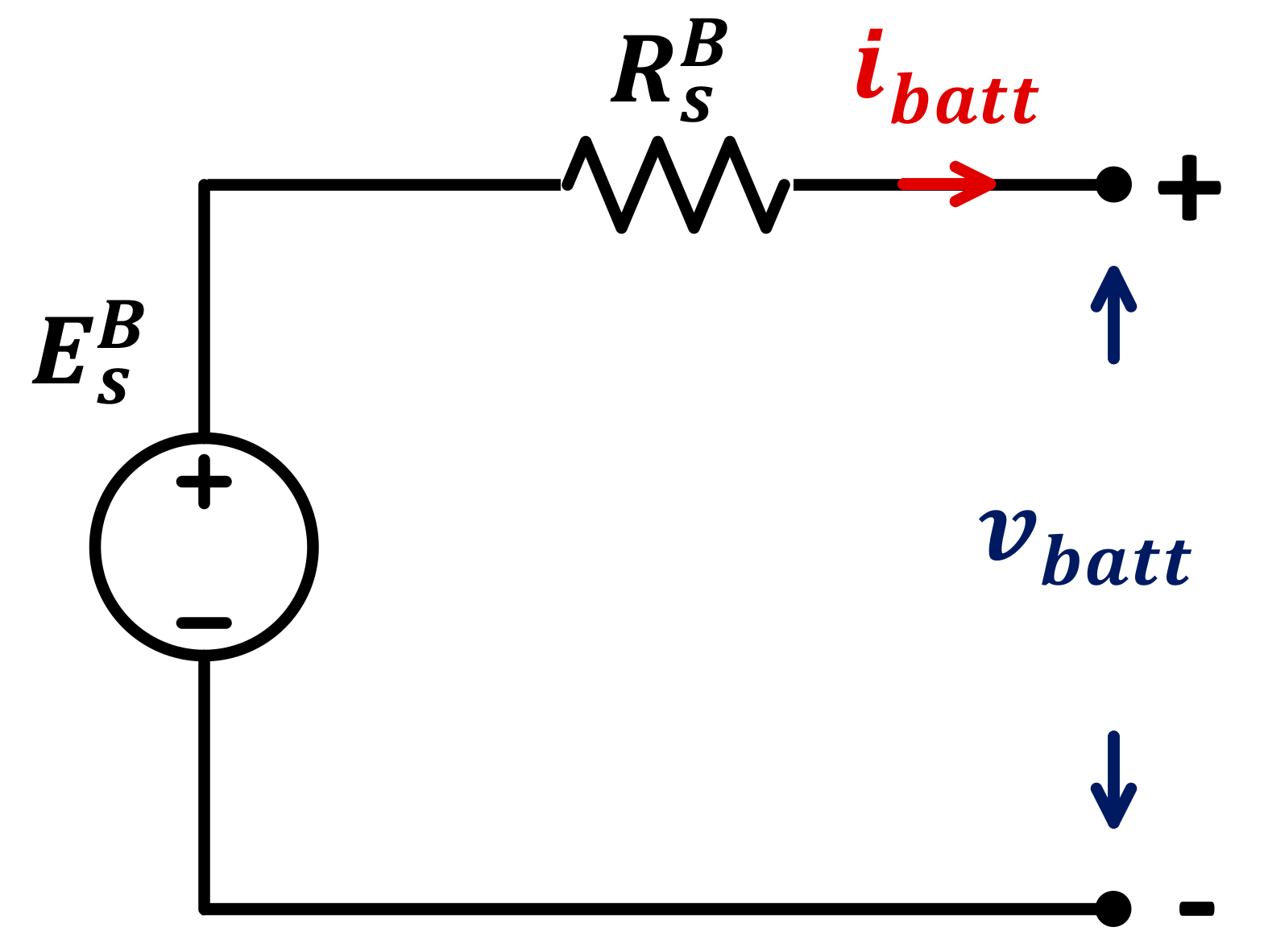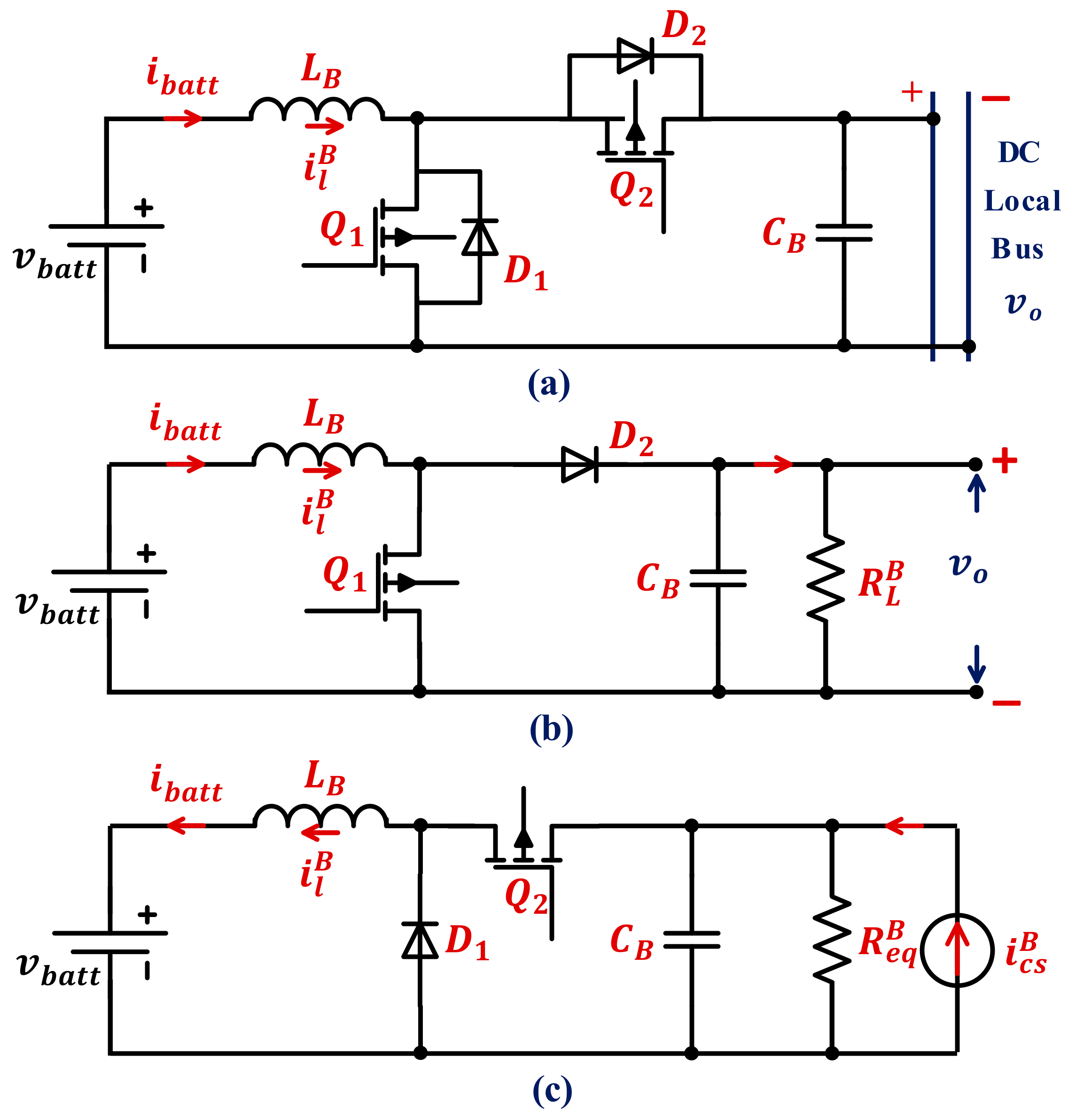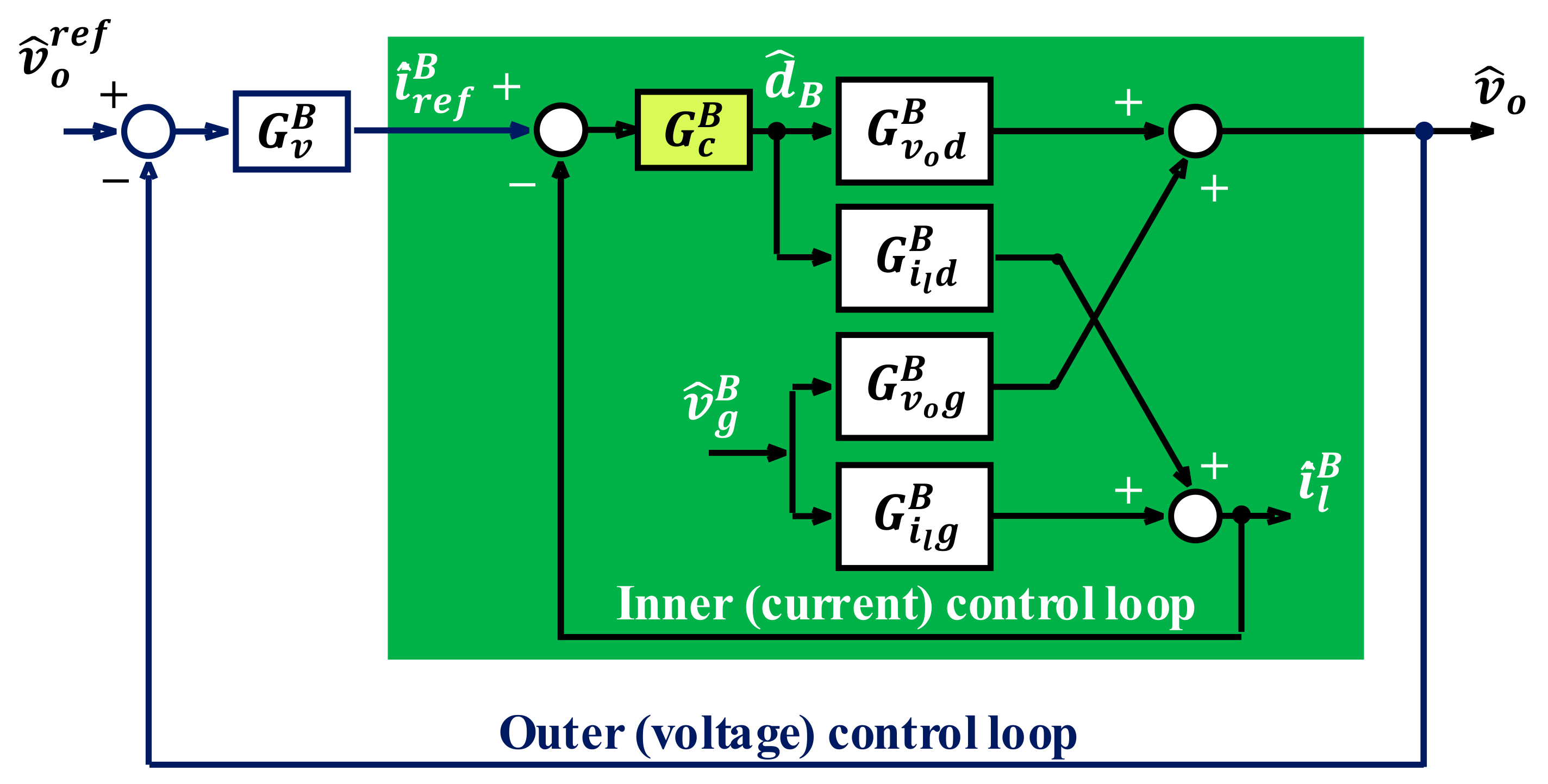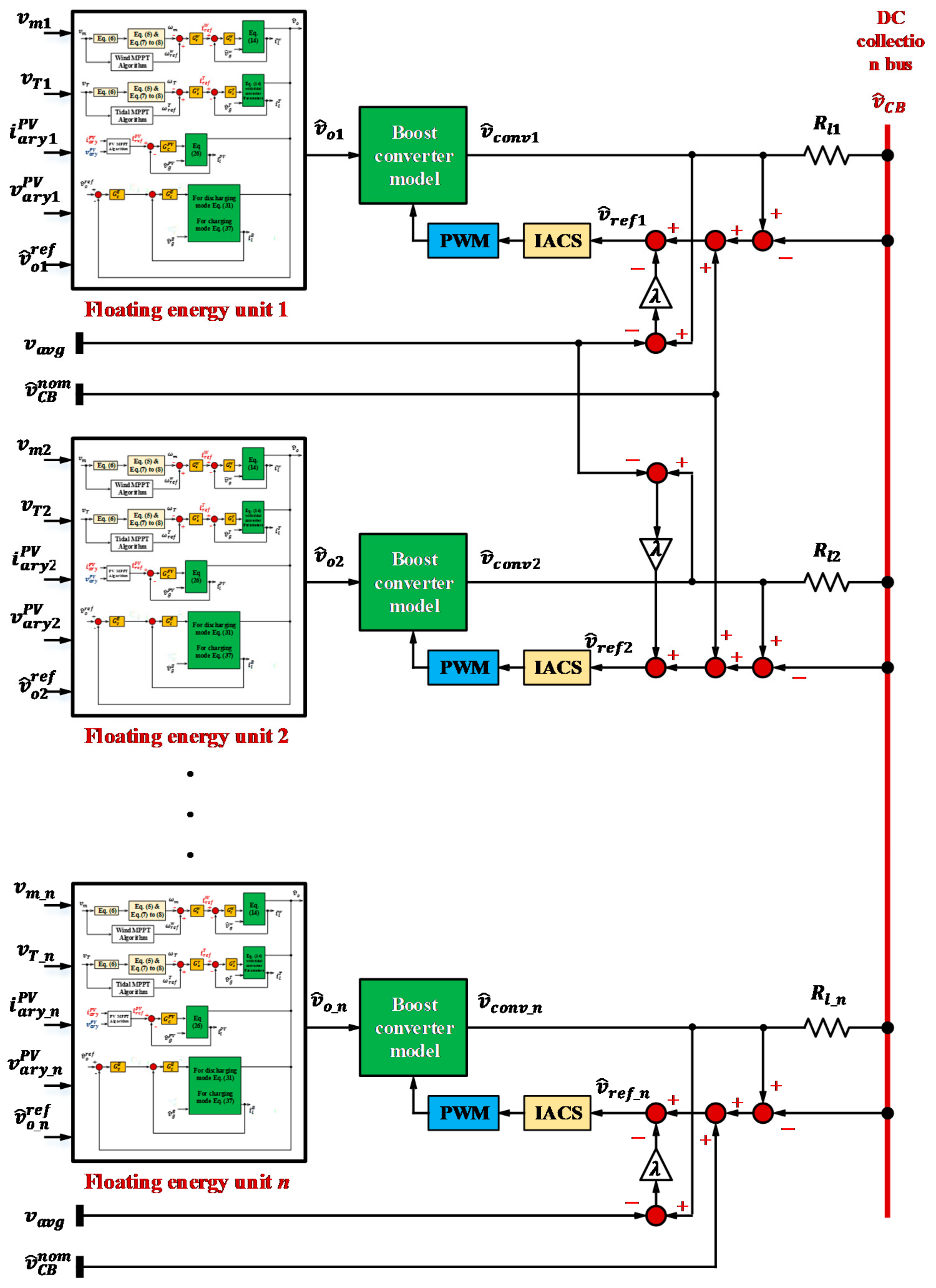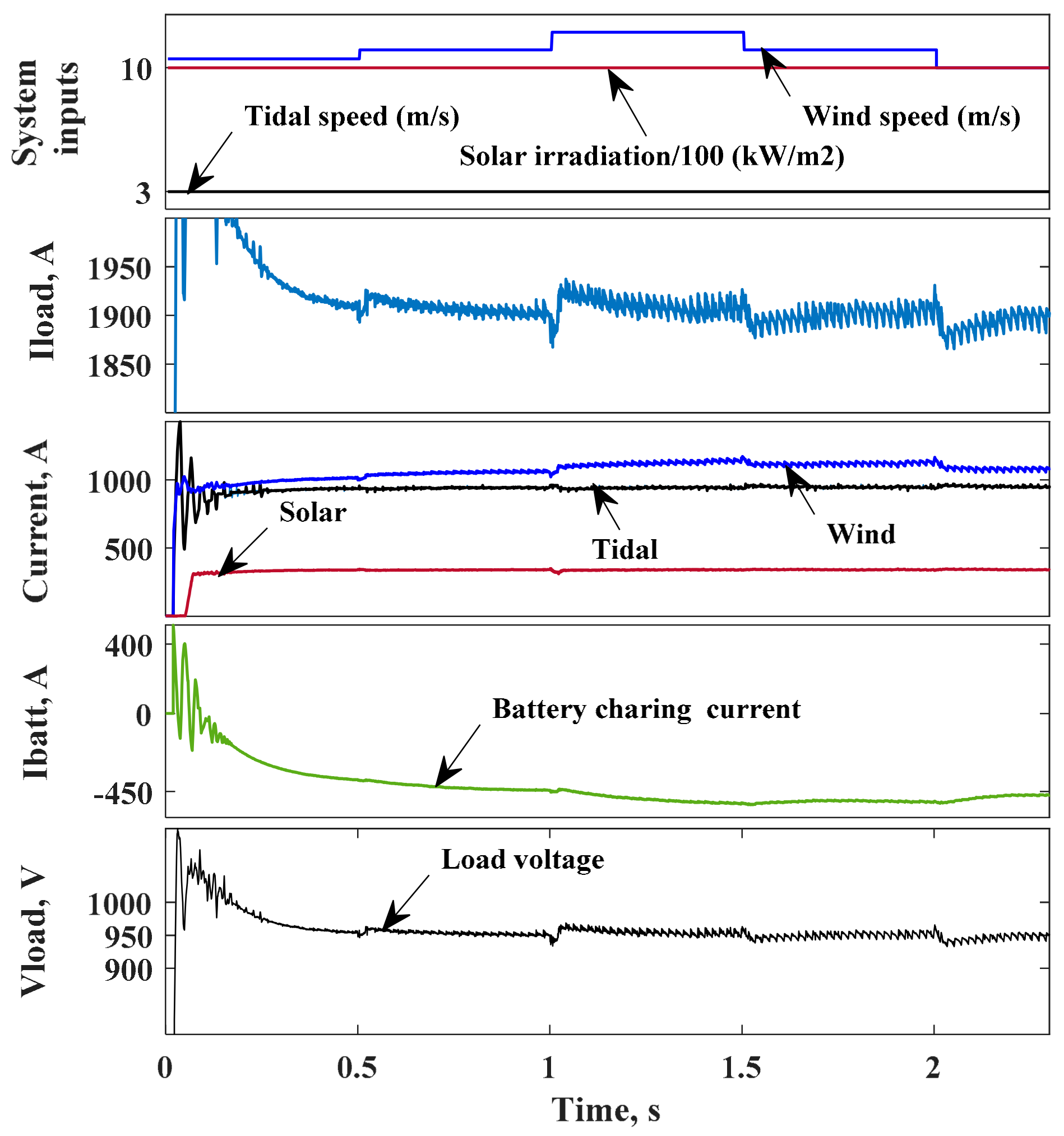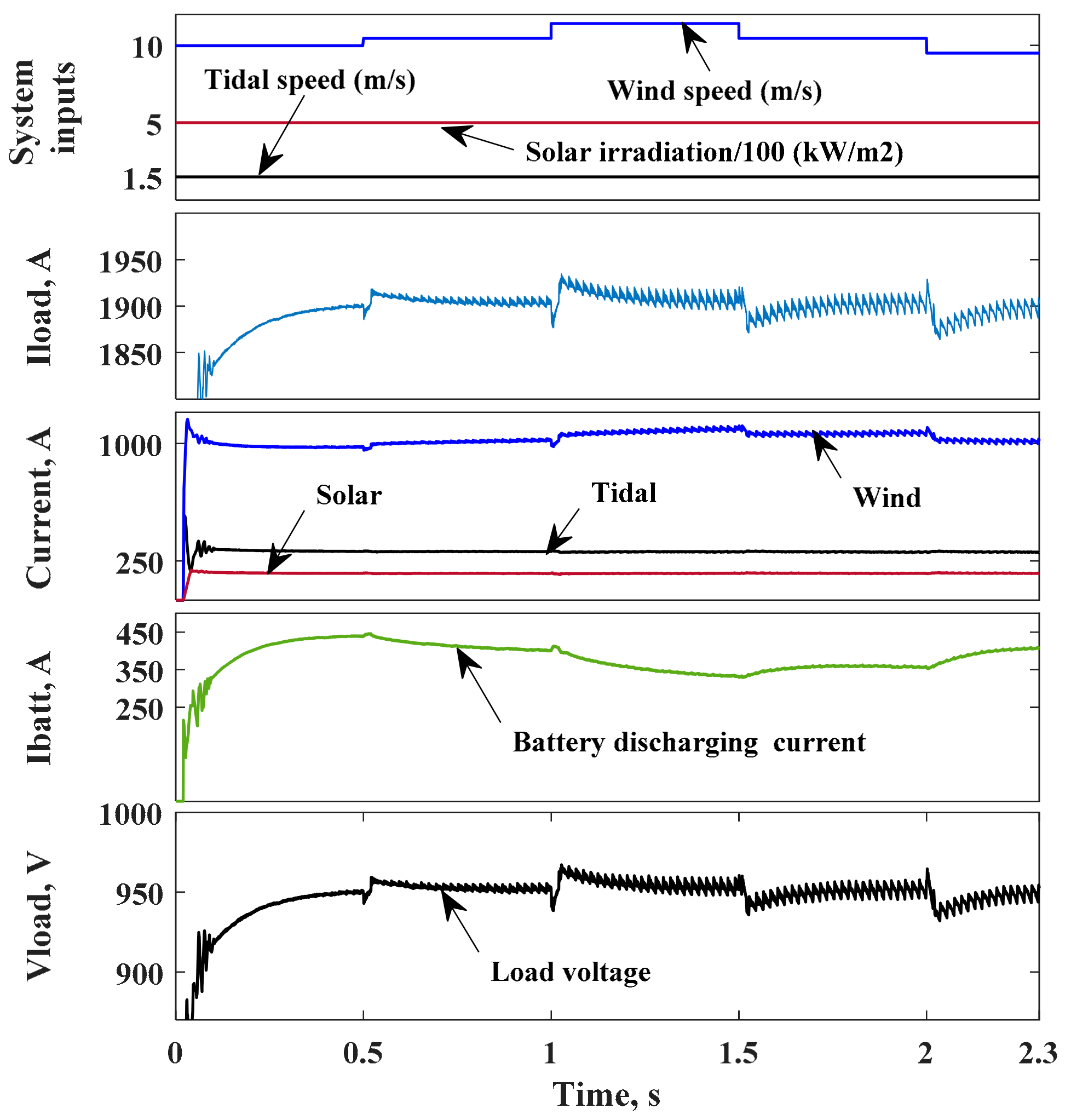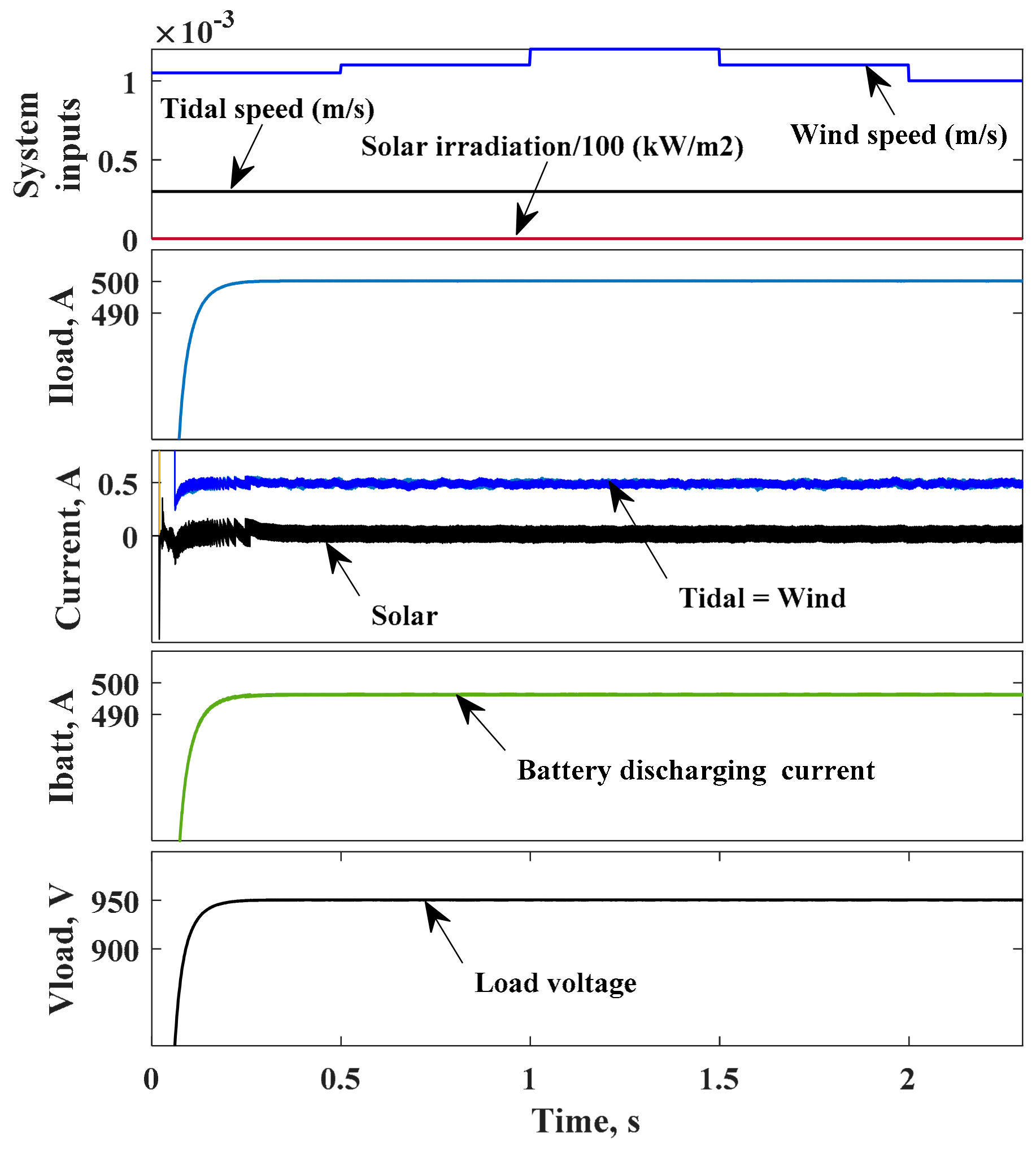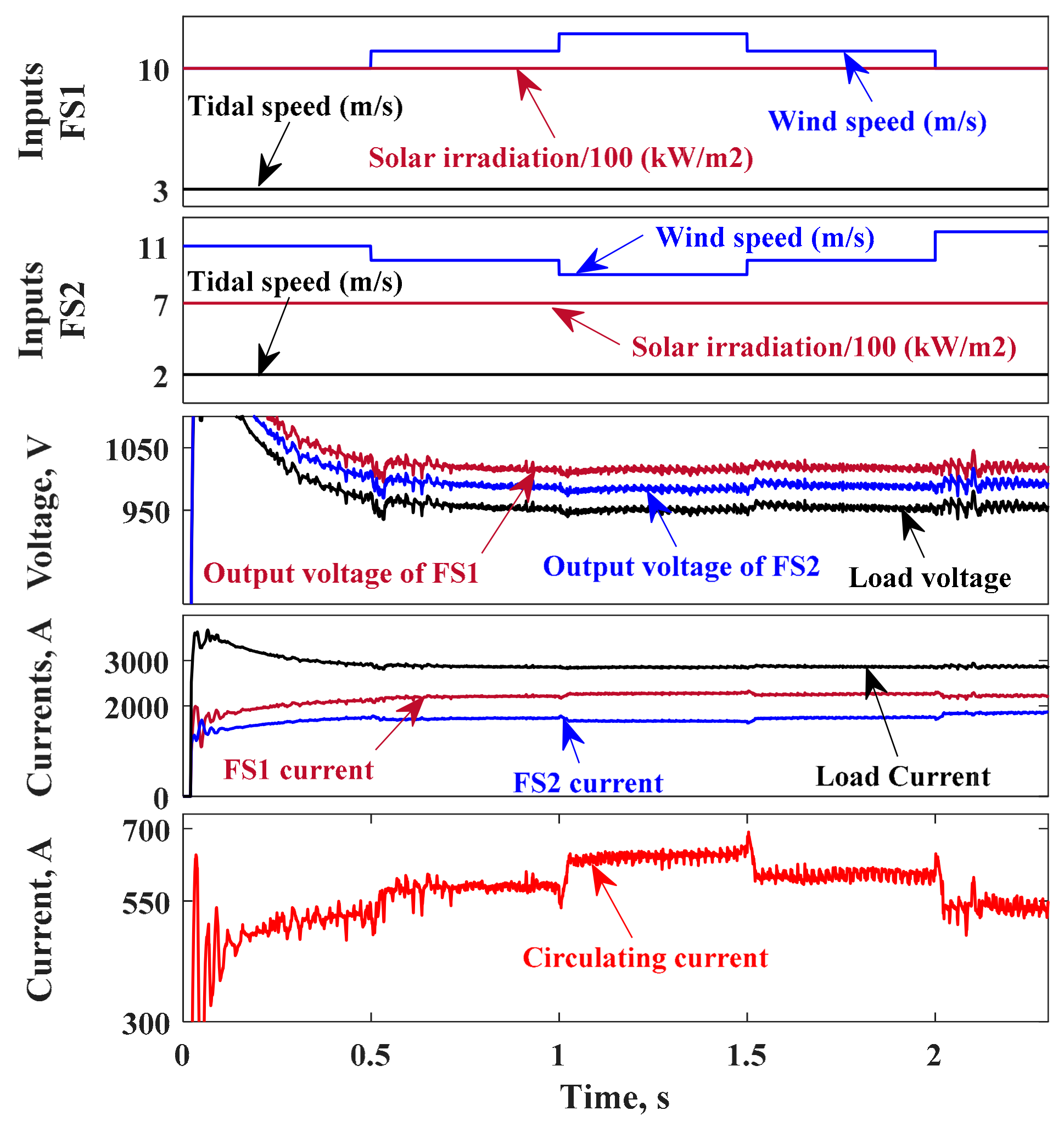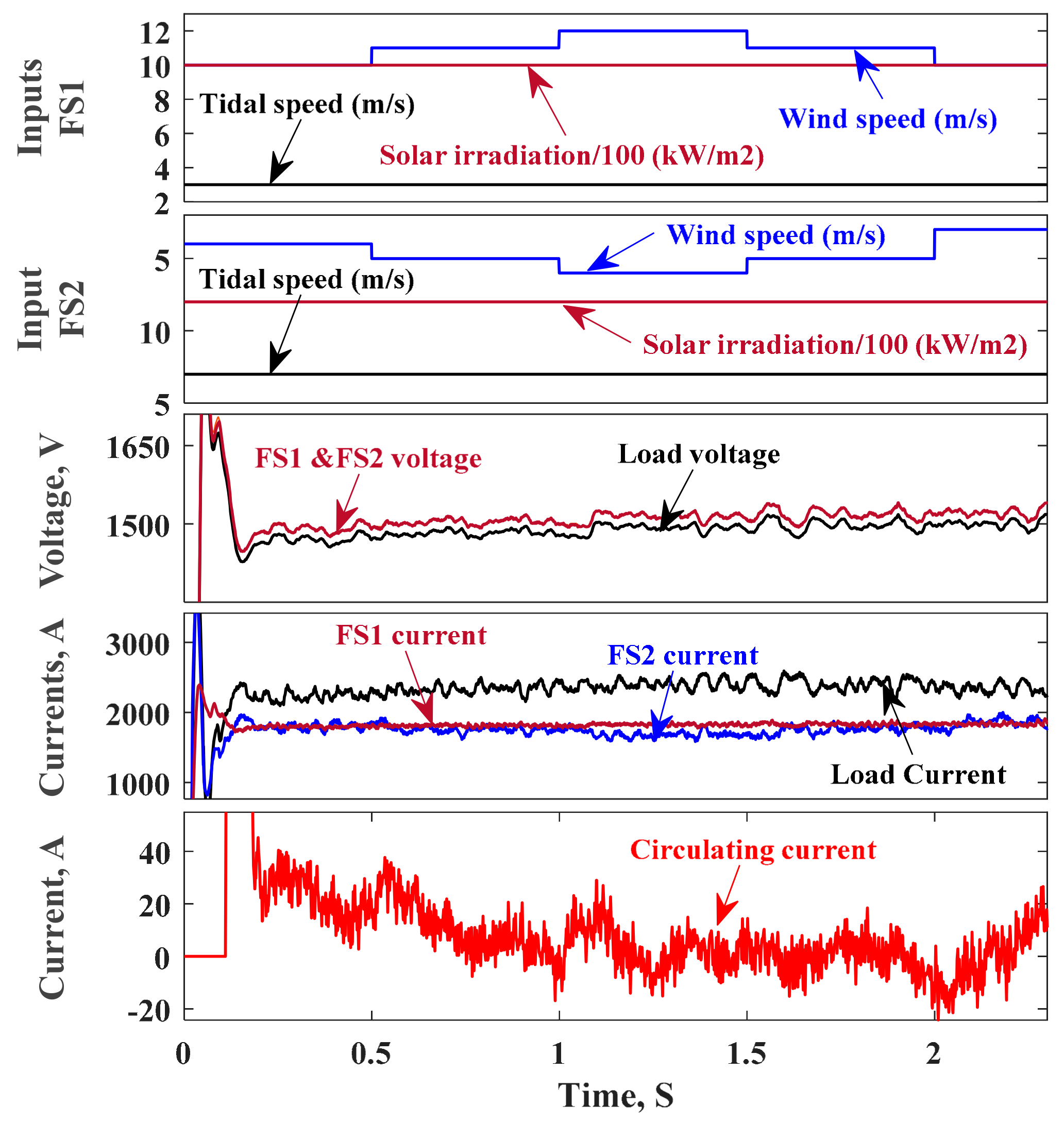4.1. Model of Wind/Tidal Turbine with MPPT Controller
As illustrated in
Figure 1, each wind or tidal turbine is connected to a Permeant Magnet Synchronous Generator (PMSG), Diode Bridge and DC/DC boost converter. Due to its widespread acceptance in wind turbines applications and its fast progress, PMSG is considered under this study to be connected to wind and tidal turbines [
30]. A boost converter is used to extract the maximum power from the wind turbine via two control loops. The first loop tracks the optimal generator speed using Proportional Integral (PI) which provides a reference for the inductor current of the second current loop. The second loop also uses PI to control the inductor current which leads to controlling the speed of the generator to operate at the optimal speeds.
Figure 3 shows the block diagram for speed control of PMSG connected to wind/tidal turbine. The following model applies to wind/tidal turbine as a similar configuration is considered for both of them under this study.
The mechanical output power of a wind turbine
can be estimated by (4)
where
,
,
,
,
are the air density, rotor swept area, power coefficient, pitch angle and wind speed, respectively.
is the tip speed ratio (
) where
is the rotor radius. The mechanical model of the wind turbine considering single mass modelling is
where
and
are the mechanical and electromagnetic torques (N.m).
and
are the shaft inertia (kg.m2) and viscous friction (N.m.s).
is the rotor mechanical speed (rad/s) where (
).
is the number of pole pairs. The relation between the mechanical output power of the turbine in (4) and the mechanical model in (5) is built by inserting
into (4). Then the mechanical torque can be expressed as a function of wind speed as follows
Study [
31] presented a detailed mathematical derivation for a PMSG model. Stator voltage of PMSG in a dq frame is
where
,
are the stator voltages (V);
,
are the stator currents of PMSG in dq frame (A).
is the stator winding resistance (Ω).
is the maximum flux linkage created by the permanent magnets (Wb).
is the rotor electrical speed (rad/s).
The generator electromagnetic torque equals
The large-signal model of a DC/DC boost converter can be represented, in general, as follows
where
and
are the boost converter inductance and capacitance, respectively.
and
are the boost converter input and output voltages, respectively.
is the duty cycle and
is the load resistance.
is the inductor current while
is the capacitor voltage. It is worth mentioning that the boost converter parameters (
,
,
,
and
) will take different symbols for various boost converters used with wind, tidal, solar and battery systems.
Equations (4)–(9) represent a nonlinear large-signal model of a wind turbine, PMSG and DC/DC boost converter. Applying linear control techniques such as PI requires a linear system. Therefore, this large-signal model can be linearized using Taylor expansion to obtain a linearized small-signal model. It is worth mentioning that all variables in the small-signal model will be denoted by hat (
) and initial values are denoted by (
). Equation (6) shows that the turbine torque
is a function of the wind speed
, turbine speed
and the pitch angle
. Replacing
in (6) with its value in (4), then taking partial derivative for (6) with respect to
,
and
by applying Taylor expansion, one can get the linearized small signal model of (6) as follows
where
The gains (
,
and
) vary by changing the system operating point. However, the turbine speed cannot be changed rapidly; hence, the effect due to the turbine speed variation on the turbine torque is ignored, i.e.,
. Moreover, the pitch control is not used for MPPT; hence, the term
in (11) should be ignored [
32]. By replacing
in (5) with (10), the linearized small signal model of a wind turbine is given.
Similarly, applying Taylor expansion for the nonlinear large-signal model of the PMSG (7), one can get the linearized small signal as follows
where
The electromagnetic torque in (8) can be linearized using Taylor expansion as follows
where
As per
Figure 3, MPPT control requires manipulating the inductor current of the boost converter to get the generator working at the optimal speed. This can be achieved by changing the duty cycle of the boost converter as a control input with feedback from the inductor current of the converter as shown in
Figure 4 of the linearized small-signal model of a current programmed DC/DC converter.
Figure 4 shows that the inductor current and the output voltage of the boost converter depend on the duty cycle and the input voltage as per these equations
where
is the voltage of the local DC-bus,
is the input voltage of the boost converter connected to the wind turbine,
and
are the inductor current and the duty cycle of the same boost converter. The transfer functions of this converter are given as follows [
33]
where
,
and
.
,
,
and
are steady-state values of the local bus voltage, duty cycle and the inductance and capacitance of the boost converter connected to a wind turbine, respectively.
Equations (10)–(15) represent the mathematical linearized small-signal model of a wind turbine, PMSG and boost converter as the block diagram of
Figure 5 shows.
Figure 5 illustrates two PI controllers with transfer functions
and
for speed and current regulation, respectively.
and
are the proportional gains while
and
are the integral gains of the speed and current controllers, respectively. The first PI controller generates the reference current for the second controller. In
Figure 5, it is required to obtain the closed-loop transfer function between the inductor current
and the reference current
for stability analysis purposes. The reference current-to-inductor current transfer function can be derived using the second line of (14) by substituting
with
and applying superposition theorem, i.e., putting
. One can get the required transfer function as follows
The stability of the current closed-loop of
Figure 4 depends on the roots of the denominator of (17) which is the characteristic equation
. The coefficients of this equation are all positive which means that all roots are on the left half-plane of the s-plane, i.e., the closed-loop current transfer function of (17) is stable.
To analyse the stability of the DC-bus voltage with varying wind speed, it is required to derive the transfer function between the voltage of the local DC-bus and the wind speed as per the simplified block diagram of
Figure 5b. The required transfer function comprises two transfer functions of
and
. The transfer function from the wind speed to the reference current can be derived from the block diagram of
Figure 5a which yields
where
and
The transfer function between the reference current
and the local bus voltage
can be obtained using
Figure 4 and (14). From
Figure 4, one can obtain
. From this equation, put the value of
into the second line of (14), and afterwards, solve for
then, put it in the first line of (14). One can get the DC-bus voltage as a function of the reference current and the input voltage as follows
where
. By substituting
into (19) with its value from (18), one can obtain the overall transfer function of a wind turbine with PMSG and a boost converter as follows
As mentioned earlier, the tidal turbine has a similar dynamic behaviour as the wind turbine as per (4) with two differences. Instead of the air density, water density is considered for tidal case, and water current speed is applied instead of wind speed. Moreover, the same configuration of a wind turbine is considered for a tidal turbine, so the overall transfer function of the wind turbine holds for the tidal turbine which can be copied from (20) considering the mentioned differences between the wind and the tidal turbines and the parameters of the turbine and the PMSG of each case.
where
,
,
and
are steady-state values of the local bus voltage, duty cycle and the inductance and capacitance of the boost converter connected to a tidal turbine, respectively.
is the mechanical output power of a tidal turbine.
is the MPPT algorithm which gives the optimal per unit rotor speed as a reference at various mechanical input powers.
is the input voltage variations of the boost converter connected to a tidal turbine.
is water current speed associated with a tidal turbine.
4.2. Model of Solar Array with MPPT Controller
A Photovoltaic (PV) array consists of many PV modules connected in series and parallel as per the required design. PV cell is the basic unit of the PV module which includes electrically connected series and parallel cells. One cell can produce electrical power around 1 to 2 W according to the available irradiance. The PV cell is modelled in literature with various equivalent circuits according to the number of diodes considered to a single-diode circuit, two-diodes circuit and three-diodes circuit. The single-diode model has the advantages of simplicity and reasonable accuracy which make it the most commonly used model for simulation studies.
Figure 6a shows the equivalent circuit of a real PV cell considering the dynamic resistances
which represents the structural resistances of the PV cell and
for modelling the leakage current of p-n junction.
refers to the current generated by the light as per (22).
where
and
are solar irradiance and the standard irradiance at the Standard Test Condition (STC).
and
are real cell temperature and the temperature at STC.
and
are the short circuit current at STC and the short circuit current temperature coefficient provided by the manufacturer.
Figure 6b shows the nonlinear relationship between the current
and voltage
outputs of the PV module described by (23).
It is worth mentioning that Equation (23) adding can be used to represent a PV module which has a number ( of series connected PV cells, where is the electron charge (1.602 × 10−19 C), is the Boltzmann’s constant (1.38 × 10−23 J/K), is the temperature of the p-n junction, and is the diode ideality factor. is the diode reverse current saturation which is a function of .
Using a single PV module in a power system is unrealistic for its low output power. Therefore, normally many modules are electrically connected in parallel and series according to the designed output power and voltage, respectively. A model of a PV system based multi-modules is derived in the study [
34] using Norton equivalent circuit. Norton theorem is applied, first, to get the equivalent circuit of a single PV module without the current source (
) and diode section to avoid nonlinearity of the diode as per
Figure 6a. Then, the Norton theorem is applied again to get the equivalent circuit of a PV system (PV array) consisting of
, series connected modules, and
, parallel connected modules, as
Figure 7 shows.
The equivalent current source and resistance are given as follows
The Equation (24) is applied to a PV array that has the same type of PV modules and exposed to the same environmental conditions. The relationship between the output current
and voltage
of a PV array is obtained based on
Figure 7a as follows
where
and
, considering the assumption of modules similarity made above.
To extract the maximum power from the PV array, a DC/DC boost converter with a current control loop is applied as per
Figure 8. A PI-controller is used to control the inductor current of the boost converter to track the reference current provided by an MPPT algorithm which is out of the scope of this study. The boost converter is chosen in this case as its input current (inductor current) is adjustable. This current is also the output of a PV array which is required to be compensated to an optimal value. Unfortunately, a buck converter could not do this job as its inductor is located at the output side, which means that the converter input current is always lower than or equal to the output current, i.e., compensating the buck converter output current does not achieve the MPPT where the output current from the array will be lower than the optimal current.
The small-signal model of a current programmed boost converter with a PI-current control loop is illustrated in
Figure 9. The transfer functions of the current programmed boost converter are derived earlier in the wind turbine section, and this is copied below with the parameters of the solar PV array.
where
,
,
and
are steady-state values of the local bus voltage, duty cycle and the inductance and capacitance of the boost converter connected to a PV array, respectively.
Figure 9 shows that the local DC-bus voltage is a function of the reference current
and the input voltage
of the converter as follows
where
. Equation (27) represents the overall transfer function of a PV system connected to a boost converter with a current closed loop. This transfer function is used for analysing the stability of the PV array.
4.3. Model of Bidirectional Buck/Boost Converter with Storage Unit Controller
Many battery models are introduced in the literature with different degrees of complexity. Study [
35] classified these models to electrochemical, experimental and electrical models. Among these categories, electrical models would be the better option to represent the batteries electrical characteristics. There are four types of batteries in the market: lead acid, nickel-cadmium, nickel-metal-hydride and lithium-ion. Lithium-ion batteries are used in large-scale applications for regulation and power management purposes [
36]. The equivalent circuit of the battery model, as shown in
Figure 10, could be applied for all battery types. This equivalent circuit includes a voltage source which is a function of the battery capacity
and the battery current
at no load. In series with this voltage source, a resistor
is connected which represents the battery internal resistance. The battery output voltage and current are denoted as
and
, respectively. study [
37] presented a dynamic model for the four battery types mentioned above.
The mathematical dynamic model of a Lead Acid battery is given in (28) and (29) for charging/discharging cycles, respectively.
where
and
are the open-circuit voltage between battery terminals during charging and discharging, respectively.
is the battery constant voltage.
is the polarization constant.
is the actual battery charge (
) where
is the battery current.
is the battery filtered current via a low pass filter.
is the exponential zone voltage which can be obtained from
where
and
are the amplitude of the exponential voltage zone and the inverse of the time constant of that zone.
refers to the current mode of the battery (
for discharge and 1 for charge mode).
To protect the batteries against rapid degradation and for controlling the DC bus voltage, a control system with two cascaded loops is employed for controlling the charging and discharging processes of the battery via a DC/DC bidirectional converter. The outer loop regulates the DC-bus voltage using a PI-controller which provides a reference current for the inner loop. The inner loop regulates the delivered (discharge mode) or received (charge mode) current by the battery via providing the bi-directional converter with the duty cycle which applied to switch Q1 (see
Figure 11) after a Pulse Width Modulation (PWM). The pulse applied to Q2 is the complement of that applied to the Q1. Turning the two switches Q1 and Q2 simultaneously would damage the converter, so proper dead time should be applied between the driving signals. The battery system is designed to work in two operation modes (charging and discharging) as an offshore islanded microgrid is considered which is supplied by unpredictable energy sources.
Figure 11 shows the bi-directional converter configuration with the converter configurations during discharging and charging mode. During step-up (discharging mode), Q2 is in off-state, and only the anti-parallel diode (D2) appeared as per
Figure 11b. While Q1 will be in off-state during step-down (charging mode) and only (D1) is represented as per
Figure 11c. Analysing the stability of the bidirectional converter requires deriving the mathematical dynamic models of the converter during boosting and bucking modes.
During discharge mode (see
Figure 11b), the bi-directional converter is typically a boost converter with the battery system at the input (low-voltage side) and the load at the output (high-voltage side). Therefore, the current programmed boost converter model derived earlier by (15) can be applied for the bi-directional converter during discharging phase. This model is copied below, considering the designed parameters of the bi-directional converter. It is worth mentioning that the battery current is equal to the inductor current of the bi-directional converter (i.e.,
)
where
,
and
. And
,
,
and
are steady-state values of the local bus voltage, duty cycle and the inductance and capacitance of the bi-directional converter connected to a battery system, respectively. Referring to (31) all transfer functions have the same denominator. This denominator implies that the converter is stable as all poles are located in the left-half plane where
,
,
and
are positive values. Moreover, the transfer function at the first line of (31) shows a zero in the right half-plane. This zero has no impact on the system at low frequencies; however, it tends to destabilize the output voltage due to phase reversal which happens at high frequencies with a duty cycle step change.
During charging mode, the current in the inductor is reversed to be delivered from the load side to the battery. The dynamic model can be derived during this mode as follows. As described earlier, the battery system is connected to an islanded DC microgrid supplied by renewable energy resources (wind, tidal and solar). These energy sources are current-controlled for extracting the maximum power, i.e., they can be modelled using Norton theorem as a current source
in parallel with an internal resistance
, where
is the total current delivered by wind, solar and tidal generators, while
is the internal equivalent resistance of these energy sources.
Figure 11c represents the DC/DC bidirectional converter during bucking mode with the battery system at the output and the current source at the input (high voltage side). To obtain the dynamic model of the bi-directional converter during charging mode, the circuit diagram of
Figure 11c is analysed when Q2 is turned ON and OFF as follows.
To maintain the nomenclature of
, the switch Q2 is activated while Q1 is switched off, and this could occur during the cycle period
. The circuit diagram of
Figure 12a is applied, which gives the system equations
where
is the equivalent resistance of
and
in parallel.
Figure 12b shows the circuit diagram when Q2 is turned off and Q1 is active which occurs during
and gives the system equations
Consider the converter switching frequency is
, then the switching cycle is
. To get the converter equation during the whole time period
, the average model of switching Equations in (32) and (33) is obtained as follows:
Equation (34) represents a nonlinear average model of the bidirectional DC/DC converter during charge mode. To obtain the steady-state values of the state variables (
and
), one can put the derivative parts in (34) equal to zero which gives
Taylor expansion is applied for the nonlinear model of (34) to get the small-signal linearized model as per (36):
Taking Laplace to transform for (36) and using superposition theorem, i.e., put
and
equal to zero, one can get the transfer functions of control
-to-output
and the line
-to-output
during battery charge mode as per the first and second lines of (37), respectively, as follows:
where
Moreover, the small-signal model (36) can be used to drive the control-to-inductor current () and line-to-inductor current () transfer functions as per third and fourth lines of (37), respectively, during charge mode.
The transfer functions of a bidirectional converter during discharging and charging phases have similar denominators as per (31) and (37). Therefore, the stability discussion held before for (31) stands for (37). The transfer function in the first line of (37) shows that there is a zero which could be in the right half or the left half-plane depending on the value of the total current supplied by the renewable energy sources comparing with the load current as follows:
However, charge mode occurs only when the current source () is higher than the load current ( considering high internal impedance for all energy sources. In other words, this zero will be always at the left half-plane.
It is worth mentioning that the transfer functions in this figure must be defined as per the battery operation phase. In other words, transfer functions of (31) are used for the discharge model, while for the charge model the transfer functions of (37) are applied in
Figure 13.
To regulate the local bus voltage
during different operation modes, a two closed loops control system is employed as described earlier in this section (see
Figure 13). The converter model with the controller shows that the output voltage variations
depends on two independent ac variables which are the input voltage
and reference voltage
variations. The following section derives the mathematical equation which relates the output voltage with these inputs.
First, obtain the closed-loop transfer function of the inner loop while the outer voltage loop is open. The relationship between the output voltage variation and the input variations of
and
is derived earlier for the boost converter of the wind turbine as per Equation (19). This equation is copied here considering the two operation phases of the bi-directional converter as follows
where
Equation (39) is derived for tuning the PI-controller of the outer loop using the inner closed-loop transfer function (
) while the input voltage
. To get the output voltage variation as a function of the reference voltage
, and the input voltage
, this can be achieved by applying superposition principle to the block diagram of
Figure 13 which yields
where
is PI-voltage controller transfer function with
and
which are the proportional and integral gains, respectively. It is important to highlight that the output voltage Equation (40) is valid for discharging and charging battery modes and so working on certain battery mode requires choosing the transfer functions derived for that mode.
Tuning the PI-controllers, and , of the inner and outer control loops can be achieved using pidtune command in Matlab. For tuning the inner loop controller , the open-loop transfer function is considered, while the open-loop transfer function (), which is the inner closed loop as per (40), is used for tuning the outer controller, . To analyze the stability and the transient behavior of the proposed controller, one should analyze the location of the poles and the zeros of and as presented in following section.
4.4. Overall Model of a Single Floating Energy Unit
Figure 14 illustrates the overall model of a single floating structure comprises a wind turbine, tidal turbine, solar array and a battery system connected to a local DC bus. Each energy source has a current loop for MPPT, while the battery system has a cascaded voltage and current loops for controlling the voltage of the local DC bus.
Figure 14 implies that the DC-bus voltage
at a floating turbine depends on the variations on wind speed
, tidal speed
and solar irradiance represented by the current reference
and the reference voltage of the DC-bus
. This can be written a mathematical form as follows
Equation (41) shows that the stability of the voltage at the local bus of a floating structure depends on the characteristic equations (i.e., the denominators of all the transfer functions between
and
,
,
,
,
,
,
and
which are
Applying the Routh–Hurwitz stability criterion, for the closed-loop transfer function of a system to be stable, the characteristic equation of that system must have all zeros on the left half-plane. Regarding the characteristic equations at the first and second lines of (42), to ensure that have all zeros on the left half-plane, one should ensure that the numerators of both terms have positive coefficients. The term
has positive coefficients as the transfer functions
and
has positive coefficients. Similarly, this analysis is held for the characteristic equations with similar term as for those in the fourth to seventh lines of (42). The term
is expanded to show its coefficients which yields
where
The steady-state currents and are negative for PMSG. The coefficients and are positive values for both SPMSG and IPMSG. First, considering SPMSG (i.e., and ), this means that is positive as the third and fourth terms of will be zero. has a positive sign as the third term goes to zero. Secondly, if IPMSG is considered (i.e., ), then the third term of will turn to negative due to the negative sign of and the fourth term will turn positive. Similarly, the third term of will turn to positive while the sign of the second term of this coefficient will be positive if (). The same analysis is applied to the characteristic equation of the tidal turbine in the second line of (42).
It is required to analyse the floating structure voltage stability during discharging and charging phases separately. The characteristic equation in the third line of (42) is considered. During discharging phase, the transfer functions of (31) are used to extract the coefficients of this characteristic equation
where
Therefore, the stability of the local voltage of a floating structure during battery discharge mode requires all coefficients to to be positive and so choosing the parameters of the PI-controllers must avoid the critical values which make the system unstable as per and .
Similarly, the coefficients of the characteristic equation during battery charging mode can be obtained using the transfer functions of (37) as follows
where
For the system to be stable during the charging phase, all coefficients to have to be positive. Therefore, tuning the controller parameters must fulfil this stability requirement.

